Partially Solved Mystery: Bunkers and Tunnels
Solved Mystery: The
Really Big Binoculars
More than a few troopers
have contacted the site asking about the German bunkers and tunnels at
Daley Barracks / Manteuffel Kaserne and the US Navy binoculars at the
border OP? Here is what we know ... can anyone help with additional
detail?
What Lies Just Beneath
In the urban archeology
classroom, the joke goes like this,
"In Russia, if you stick
a shovel in the ground, in a minute or two, you will turn up human
bone fragments. Never have so many people died: Swedes, Finns, Poles,
Italians, Turks, French, British and Germans in such a distant land to
possess such a far horizon. When not resisting invasion, the Russians
slaughtered each other in astounding numbers. In Russia, what is not
already a cemetery is just waiting its turn."
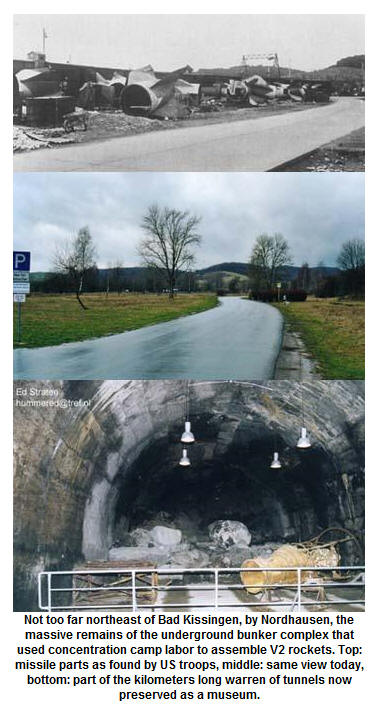
"In the USA, on the other
hand, the same shovel and a few minutes of work will uncover pieces of
rebar steel, broken concrete and brick. What was the ‘ new, bright and
bold project of the 1950s ‘ was summarily leveled to make room for the
‘ massive, much needed and innovative project of the 1980s ‘ ...
followed in due course in the year 2000 by the ‘ demanded and
carefully visualized new project to accommodate a new business climate
...’ and so on. It’s the Full Employment Act for architects and
laborers ... we build, we raze and we build again."
"... and in Germany,
where the past is much protected and the present is an art form, stick
a shovel in the ground and you will find a ... bunker! France had
cathedrals, England has castles and Germany ... from World War II
through both the Soviet and Allied sides of the Cold War ... there are
bunkers .... thousands of them. It was as if by pulling a concrete
blanket up, by digging deeper with more wooden forms and rebar steel,
somehow, whatever catastrophe might happen would just go away ... or
at least allow the bunker inhabitants a few more months, a few more
days or a few more hours. In Germany, they have bunkers." .
The Bunkers of Daley
Barracks / Manteuffel Kaserne
With the barracks area on
a hill, clearly the builders had terraced the central part of the
Kaserne to create a two tiered level. The fill material probably came
from the excavations of the various foundations. The lower tier was
the flag pole area immediately in front of the cavalry mess hall. With
your back to this building, cut into the rising hill, ascending
concrete steps led to the upper tier consisting of the Parade Field
running towards the VII Corps units consolidated mess. On the
perimeters, just adjacent to the streets running by the various
barracks on both sides, were welded shut steel doors apparently
leading to chambers under the Parade Field. A vast bunker in the
center of the Kaserne ... what a surprise?! I recall the troops
speculated on this endlessly and even planned expeditions but if
anyone ever penetrated the doors, the story was not passed on.
This is
what we remember, what we know and also where the story goes
cold. We have yet to find a photo collection or a single image
that recalls the 2 Krad or Recon Bn of the 2 Leichte Dv at
Manteuffel that accounts for the "chamber" beneath the
Parade Field. There were several entrances and it seems
plausible that there was either a single large bunker or, a
series of several small scale chambers each with its own door.
Based on photos of
similar Kasernen built during the pre war period, the evidence
suggests the motorcycle sets of the Krad Bn were stored in long wooden
sheds adjacent to the motor shops but gone by the time the US Army
enters the scene. The Nazi trucks and field cars of this same era
would have been parked on the cobblestone aprons in front of each
motor shop. The earliest photographic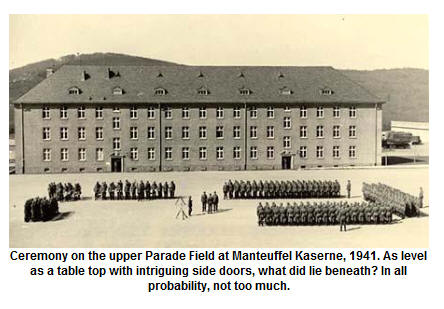 evidence of Mantueffel from the
photo albums assembled by medics in training during the war years
indicate that construction was complete by 1940. Several images
capture soldiers on the Parade Field, no images of bunkers or
perimeter doors.
evidence of Mantueffel from the
photo albums assembled by medics in training during the war years
indicate that construction was complete by 1940. Several images
capture soldiers on the Parade Field, no images of bunkers or
perimeter doors.
With some minor
variations, the Germans barracks builders recycled their blueprints
during the mid 1930s wave of construction. On post bunkers did not
appear in Fulda or Hersfeld but interestingly, even in the 1970s and
early 1980s, there were Stars and Strips reports of the "flooded
German hangers at various Luftwaffe bases" now in American
hands. The areas were strictly off limits but well known and bunkers
for aircraft involved in the defense of the Reich against air attack
does make perfect sense. But why would there be bunkers or chambers
under the Parade Field at Manteuffel / Daley?
Once the war began, there
were massive German construction projects to move key industries and
government functions into bomb resistant bunkers. With the army
deployed and the various Kasernen in use as training bases, no readily
available evidence points to a similar program to build shelters for
recruits. Further, a bunker of any size would have required an
extensive ventilation system; there is no evidence of this in any of
the photos. Could the doors have led to small chambers only dug deep
enough to conveniently store training ammunition for the German
troops?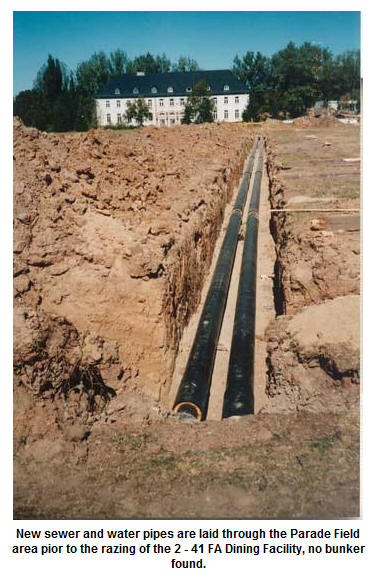
This seems a thoroughly
plausible explanation and it is our best guess. During the 2000
cavalry reunion, a briefing for attendees was presented by the city of
Bad Kissingen and this very question came up. The woman giving the
presentation stated that no bunkers were found during the excavations
associated with redevelopment and the newspaper photos indicate that
the Parade Field area was significantly reworked. The size of the
chambers and their use, beyond our speculation, remains a mystery. But
what about those interconnecting tunnels running between the
buildings?
Tunnels
As you may recall, in the
basement of each building, at the corridor ends were heavy steel doors
locked shut. Where did the sealed doors lead? We wondered about it in
1978 and have only a partial explanation in 2004.
I don’t know if the major
building upgrade in 1985 addressed real property mechanical issues of
the Kaserne but in the early 1980s, all eight buildings creating the
large rectangle were heated by steam baseboard radiators. I suspect
this dates back to at least the 1972 - 1973 upgrade, perhaps to the
initial upgrade of the barracks just prior to the arrival of LTC
Spurrier’s recon battalion.
The barracks buildings
were interconnected by a series of tunnels, heavily padlocked steel
doors at both corridor ends prevented eager scouts from exploring. The
exception was the H Co and Trp F building that only had one set of
doors, on the down hill side running towards Trp E and G building.
This was all part of the heating system.
Steam was created at a
coal fired heating plant behind the 2 - 41 FA barracks area; there was
a silvered smoke stack with a scrubber on the end. Steam heat needs to
run in a closed circuit, steam out and water return, the pipes appear
to have run in two long loops servicing both sides of the barracks
area. To move the needed volume of steam and water, the pipes had an
industrial capacity and the maintenance "raceway" 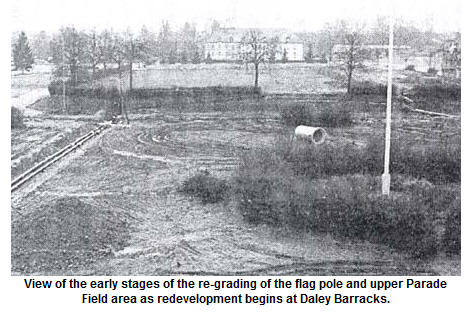 for the pipes
and valves ran from building basement to basement accessible though
the steel doors in the basement corridor. One trooper wrote to recall
that once, the road between the Trp F and H Co building and the Trp G
and E Trp building was cut as the German Facility Engineers dug the
entire steam tunnel up during repairs.
for the pipes
and valves ran from building basement to basement accessible though
the steel doors in the basement corridor. One trooper wrote to recall
that once, the road between the Trp F and H Co building and the Trp G
and E Trp building was cut as the German Facility Engineers dug the
entire steam tunnel up during repairs.
In a final note, at least
up to the 1985 rehabilitation, the hot water for each barracks shower
and laundry was created by oil fired boilers contained in each
building and for the ever growing cavalry squadron, there was never
sufficient hot water at the end of an FTX.
If you return to the Bad
Kissingen area with an interest in history and bunkers, however, the
remains of our ASP / CL V point are for the most part intact. A short
drive to the north and in the former Soviet training areas at Dollmar
- Meiningen, one may kick around the Soviet bunkers and not too far
away are significant bunkers remaining from the Nazi period. A Google
search will yield any number of links,
this site is a good start
particularly for Cold War related bunkers.
This is one
Any number of other web
sites discuss various Nazi complexes from Berlin to East Prussia to
the Eiffel region, happy hunting!!
Naval
Binoculars at OP Sierra
At OP Sierra, through the
late 1970s, mounted on a heavy US Navy stand, was a massive binocular
set. Each front lenses measured at least four inches across; including
the base, stamped as ‘ US Navy Shipyard - Brooklyn NY ‘ the entire
device must have weighed at least 200 pounds. An odd item to turn up
on the East - West German border. Dating from WWII, the US Navy
employed binoculars up to 20 power by 120mm ocular width. I believe
this is what was located at the OP.
Robert Stefanowicz
"In 1978, I recall the
device was at the OP, in the bunker on the left side. Looking through,
there were problems. A series of finger levers on each side of the
binocular allowed the viewer to engage sliding colored lenses, gray,
yellow and green to suite the lighting conditions. One side was
hopelessly jammed with a pair of lenses in a ½ engaged position.
Looking towards Meiningen through the binocular, one side was sort of
clear, the other had the half green - half yellow split and the entire
device desperately needed to be purged and repaired. The NCO in charge
of the OP that day flatly told me the binocular was "broke-dick"
and, for a new Lt, that pretty much ended the conversation. I
certainly recall seeing the set at the OP on my first two border
tours. A few years later, as the Border Officer, the binos were long
gone and already fading from the active memory of the Eaglehorse."
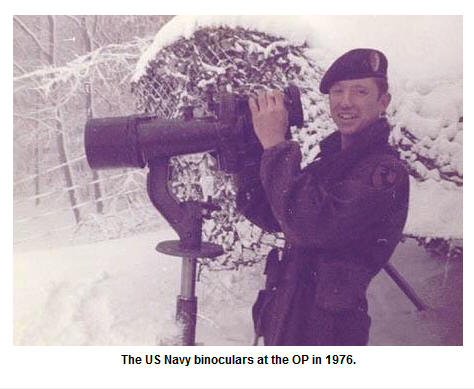
Col (RET) Jack Tartella
"Here’s the story on
those binos. The ‘naval binoculars‘ were placed at OP Sierra, as they
were placed at every other US Army OP along the East/West German
border during the mid to late 1960s. They were procured and provided
to the Cavalry Regiments by what was then called US Army Electronics
Command, Ft Monmouth, NJ (ECOM). I was told that fact by Colonel
Lyle Bowman, Director of Research, ECOM, in 1977. I imagine that
they had somehow come out of the US Navy inventory."
"The problem with the
‘naval binoculars‘ was they were subject to the weather, fogged up and
proved to be useless when the temperature changed, and therefore
needed consistent maintenance, in the form of ‘ purging ‘.
Neither Squadron Maintenance or the DSU unit had the proper fittings
to really do the job. The 2d Squadron's ‘naval binoculars
‘ was the last set in use along the border when finally turned
in for disposal in 1978."
CPT (Ret) Sam Carlson
"Jack certainly has the
detail well recalled. All I can add is that they were maintenance
headaches and getting them turned in as unserviceable was not as easy
as you would think. I guess they had existed as a special program, no
known national stock number, and the guys in the Army optics supply
and maintenance chain had to do a lot or research before they would
accept them. Finally the issue was brought to the attention of the US
Navy. It turns out they were very interested in the big binos, they
were considered historically significant."
9/1/2004 -
Update - Rick Laws
I was the
one who researched the item for turn in. The Binos were
mounted to a concrete pole outside the OP. They were at a good
vantage point for observation, much like what you would see at a
tourist overlook. Actually they had double optics/lenses much
like a regular binocular, but so heavy you could not hold them up to
look through without support.
Anyway, they had been at the OP a number of years and were on the
Squadron property book. The data plate still affixed to the
binos but they were so old and handled so often that the stamped in
numbers were rubbed smooth and no longer readable. Because they
remained out of doors during all sorts of weather, the focusing
adjustments were frozen, and vapor had gotten to the inside and
caused the tubes to fog. Plus the lenses were pretty scratched
up. Nevertheless, there was an attachment to the binos and the
S2 wanted to try to get them repaired. The stock number that
was on the property book didn't match anything on the Army Master
Data File (AMDF) that was then on microfiche. Mr Munster a
German civilian at the 493rd Supply and Support) in Wurzburg helped
research the stock number from some older hardcopy printed stock
number references and discovered the item was actually Navy ship
binos (duh). The real issue for identifying the stock number
was the source of supply to attempt to have them repaired. The
only place they could be sent to for repair or classification was at
the Rota shipyard in Spain. So the squadron had to turn the
item in as unserviceable to the 493rd S&S, who probably junked it at
the Property Disposal Office (PDO) now called DRMO (Defense
Marketing and Reutilization Office).